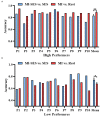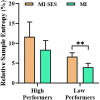The Effects of Sensory Threshold Somatosensory Electrical Stimulation on Users With Different MI-BCI Performance
- PMID: 35784856
- PMCID: PMC9247255
- DOI: 10.3389/fnins.2022.909434
The Effects of Sensory Threshold Somatosensory Electrical Stimulation on Users With Different MI-BCI Performance
Abstract
Motor imagery-based brain-computer interface (MI-BCI) has been largely studied to improve motor learning and promote motor recovery. However, the difficulty in performing MI limits the widespread application of MI-BCI. It has been suggested that the usage of sensory threshold somatosensory electrical stimulation (st-SES) is a promising way to guide participants on MI tasks, but it is still unclear whether st-SES is effective for all users. In the present study, we aimed to examine the effects of st-SES on the MI-BCI performance in two BCI groups (High Performers and Low Performers). Twenty healthy participants were recruited to perform MI and resting tasks with EEG recordings. These tasks were modulated with or without st-SES. We demonstrated that st-SES improved the performance of MI-BCI in the Low Performers, but led to a decrease in the accuracy of MI-BCI in the High Performers. Furthermore, for the Low Performers, the combination of st-SES and MI resulted in significantly greater event-related desynchronization (ERD) and sample entropy of sensorimotor rhythm than MI alone. However, the ERD and sample entropy values of MI did not change significantly during the st-SES intervention in the High Performers. Moreover, we found that st-SES had an effect on the functional connectivity of the fronto-parietal network in the alpha band of Low Performers and the beta band of High Performers, respectively. Our results demonstrated that somatosensory input based on st-SES was only beneficial for sensorimotor cortical activation and MI-BCI performance in the Low Performers, but not in the High Performers. These findings help to optimize guidance strategies to adapt to different categories of users in the practical application of MI-BCI.
Keywords: EEG; brain-computer interface; functional connectivity; motor imagery; sensory threshold somatosensory electrical stimulation.
Copyright © 2022 Chen, Zhang, Wang, Gu, Zhang and Ming.
Conflict of interest statement
The authors declare that the research was conducted in the absence of any commercial or financial relationships that could be construed as a potential conflict of interest.
Figures








Similar articles
-
Enhancing Visual-Guided Motor Imagery Performance via Sensory Threshold Somatosensory Electrical Stimulation Training.IEEE Trans Biomed Eng. 2023 Feb;70(2):756-765. doi: 10.1109/TBME.2022.3202189. Epub 2023 Jan 19. IEEE Trans Biomed Eng. 2023. PMID: 36037456 Clinical Trial.
-
Sensory threshold neuromuscular electrical stimulation fosters motor imagery performance.Neuroimage. 2018 Aug 1;176:268-276. doi: 10.1016/j.neuroimage.2018.04.005. Epub 2018 Apr 22. Neuroimage. 2018. PMID: 29689307
-
Improving Motor Imagery-Based Brain-Computer Interface Performance Based on Sensory Stimulation Training: An Approach Focused on Poorly Performing Users.Front Neurosci. 2021 Nov 5;15:732545. doi: 10.3389/fnins.2021.732545. eCollection 2021. Front Neurosci. 2021. PMID: 34803582 Free PMC article.
-
Is motor-imagery brain-computer interface feasible in stroke rehabilitation?PM R. 2014 Aug;6(8):723-8. doi: 10.1016/j.pmrj.2014.01.006. Epub 2014 Jan 12. PM R. 2014. PMID: 24429072 Review.
-
The Effects of Sensory Electrical Stimulation and Local Vibration on Motor Learning and Motor Function.Phys Ther Res. 2025;28(1):9-13. doi: 10.1298/ptr.R0036. Epub 2025 Mar 13. Phys Ther Res. 2025. PMID: 40321688 Free PMC article. Review.
Cited by
-
A Complementary Dual-Mode Ion-Electron Conductive Hydrogel Enables Sustained Conductivity for Prolonged Electroencephalogram Recording.Adv Sci (Weinh). 2024 Oct;11(38):e2405273. doi: 10.1002/advs.202405273. Epub 2024 Aug 8. Adv Sci (Weinh). 2024. PMID: 39116352 Free PMC article.
-
Evaluation of EEG Oscillatory Patterns and Classification of Compound Limb Tactile Imagery.Brain Sci. 2023 Apr 13;13(4):656. doi: 10.3390/brainsci13040656. Brain Sci. 2023. PMID: 37190621 Free PMC article.
References
LinkOut - more resources
Full Text Sources

